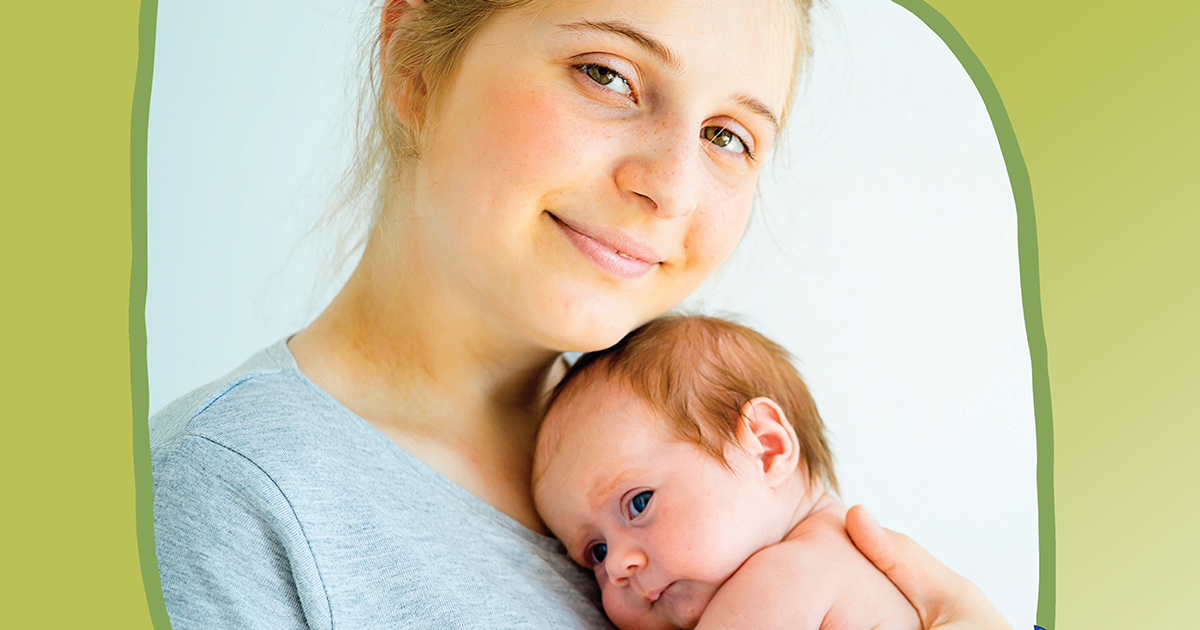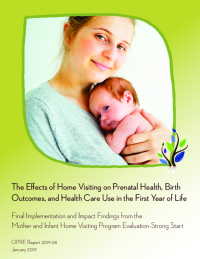The Effects of Home Visiting on Prenatal Health, Birth Outcomes, and Health Care Use in the First Year of Life
Final Implementation and Impact Findings from the Mother and Infant Home Visiting Program Evaluation-Strong Start

 Improving birth outcomes among socioeconomically disadvantaged women has been a long-standing policy goal. One potential approach to improving birth outcomes is home visiting, which provides pregnant women and families who have young children with education and support, assessment, and referrals to community services. A few prior studies of evidence-based home visiting models — specifically, Healthy Families America (HFA) and Nurse-Family Partnership (NFP) — revealed some improvements in low birth weight and preterm birth. However, these results have not been found in all prior studies of the models’ examinations of birth outcomes and were conducted years ago, from the late 1970s through the early 2000s. Given that both families and local programs have changed since those studies were completed, a new test of whether home visiting programs can improve birth outcomes was warranted.
Improving birth outcomes among socioeconomically disadvantaged women has been a long-standing policy goal. One potential approach to improving birth outcomes is home visiting, which provides pregnant women and families who have young children with education and support, assessment, and referrals to community services. A few prior studies of evidence-based home visiting models — specifically, Healthy Families America (HFA) and Nurse-Family Partnership (NFP) — revealed some improvements in low birth weight and preterm birth. However, these results have not been found in all prior studies of the models’ examinations of birth outcomes and were conducted years ago, from the late 1970s through the early 2000s. Given that both families and local programs have changed since those studies were completed, a new test of whether home visiting programs can improve birth outcomes was warranted.
The Mother and Infant Home Visiting Program Evaluation-Strong Start (MIHOPE-Strong Start) was launched in 2012 to test whether evidence-based home visiting provided during pregnancy improves birth outcomes, prenatal health, and health care use in infancy. Specifically, the MIHOPE-Strong Start analysis includes 2,900 families across 66 local HFA and NFP home visiting programs in 17 states. The Administration for Children and Families partnered with the Centers for Medicare and Medicaid Services and the Health Resources and Services Administration to sponsor MIHOPE-Strong Start. MDRC conducted the evaluation in collaboration with James Bell Associates, Johns Hopkins University, Mathematica Policy Research, and New York University. This report presents final implementation and impact results from the study. A separately published report from the Mother and Infant Home Visiting Program Evaluation (MIHOPE) presents program effects on a wider range of family outcomes and for two additional evidence-based models.
Primary Research Questions
-
What services do families receive from home visiting programs to promote prenatal health and improve birth outcomes?
-
What are the effects of evidence-based early childhood home visiting on prenatal care, birth outcomes, and infant health care use?
-
How do the effects of home visiting programs vary across different types of families, based on the features of local programs, and according to the dosage of home visiting services families receive?
Key Findings and Highlights
-
Families who received at least one home visit had an average of eight visits over four months before the woman gave birth. Families received a similar amount of home visiting as found in prior studies, including those that found reductions in the percentage of infants born preterm or with low birth weights.
-
Women who were more and less vulnerable to poor birth outcomes received similar levels of home visiting services. Among women who received at least one home visit, those who exhibited risks for compromised birth outcomes (such as being of a younger age or being a smoker) received the same number of visits and participated for similar lengths of time, on average, as women who didn’t demonstrate such risks.
-
The home visiting programs in the study had no statistically significant effect on the evaluation’s focal outcomes, including families’ prenatal behaviors, birth outcomes, or health care use in the first year after birth. The estimated differences found in the study’s main outcomes, such as low birth weight and preterm birth, are small, and they are not statistically significant.
-
Effects of the home visiting programs in the study are not greater for higher-risk or for lower-risk families or depending on how the programs were implemented. Home visiting did not have larger effects on prenatal behaviors, birth outcomes, or health care use after birth for any subgroups of families, nor do the effects vary across local programs or by evidence-based model.
One reason that the effects of home visiting in this study are small might be that there was little room for improvement on modifiable risk factors such as smoking, nutritional support, and access to prenatal health care. For example, only a small percentage of women smoked during pregnancy and most had access to health care providers during and after pregnancy. Another possible reason is that families did not receive as many home visits as the evidence-based models had intended, although they participated at levels similar to those found in prior HFA and NFP evaluations of birth outcomes. In addition, the findings are specific to the primarily urban sample of local programs and families, who would have had greater access to alternative prenatal health care services, and may not be generalizable to home visiting in areas where access to prenatal health care might be more limited.
It is important to remember that at the time of MIHOPE-Strong Start’s launch, previous studies of the evidence-based models’ effectiveness at improving birth outcomes were inconsistent or relevant only to subgroups of families. In addition, these studies’ analyses of birth outcomes were completed between 15 and 40 years ago, and the characteristics of families who are eligible for home visiting have changed; for example, the prevalence of smoking is lower and home visiting programs have evolved, raising the question of whether the next generation of programs is more likely to have effects on birth outcomes. MIHOPE-Strong Start provides new evidence that home visiting, as implemented by the local programs in this study, did not have a substantial effect on improving birth outcomes for the first birth after women enrolled in the program. Research on the epidemiology of newborn health suggests that it is challenging for any single intervention to improve birth outcomes, given the cumulative effects of stress that women with low incomes often experience. Whether home visiting programs may have longer-term impacts, including positively affecting birth outcomes for later pregnancies, is a question for future research. Furthermore, as local programs in this study were recruited from 2012 to 2015, it is possible that they have continued to evolve over the past few years in ways that could make them effective at improving birth outcomes.
Methods
MIHOPE-Strong Start included home visiting programs that implemented either HFA or NFP, two widely used models and the only ones with some prior evidence of having effects on improving birth outcomes at the time programs were recruited into the study. Sixty-six local programs that primarily served Medicaid beneficiaries contributed to the MIHOPE-Strong Start analysis. Local programs did not have to be receiving MIECHV funding to participate in the study. A total of 2,900 women who were no more than 32 weeks pregnant and were eligible and interested in receiving home visiting were included in the analysis. Families were randomly assigned either to a local home visiting group or to a control group whose members were given information on other appropriate services in the community. The random assignment design was intended to create program and control groups that were similar when they entered the study, so that systematic differences between the two groups in the outcomes of interest could be attributed to the home visiting services rather than to the preexisting characteristics of the women. Although 14 percent of the program group sample received no home visiting, all program group families were included in the analysis even if they did not receive any services, as is standard practice in studies that use random assignment. This was done to maintain the comparability between program and control groups generated by random assignment.
Information on program implementation comes from family surveys at baseline, descriptions home visitors provided about the services they delivered to families, surveys of home visitors and local program managers, interviews and surveys with evidence-based model developers, and management information system data. For the impact analysis, family outcomes were obtained from state vital records and Medicaid data.






